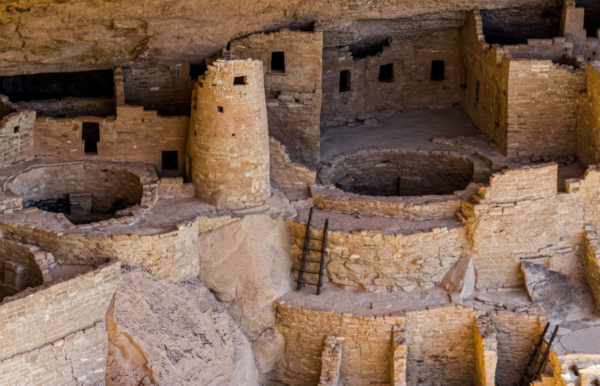There are certain images that come to the minds of many when thinking about pre-colonisation Native Americans: one may think of tepees, feathered headdresses and, thanks to stereotyped and often negative imagery peddled by the old Spaghetti Western movies and similar, a simple or even savage way of life. This image of a scattered people helps to support the idea that Columbus ‘discovered’ the country, and almost implies that it was still ‘up for the taking’. However, in 1492 AD, when Columbus first stepped foot on what is now known as the American continent, there was a thriving, diverse, and highly developed civilisation already living there. These were the indigenous peoples, and they lived in towns and cities.

A great example of the awe-inspiring skill that this culture possessed can be seen in the Cliff Dwelling of the Mesa Verde region, in the South West of the United States. The area that covers the intersection of Utah, Colorado, Arizona and New Mexico is home to the Pueblo peoples, and has been for the past 2000 years. There are 567 federally recognised tribes in the area (which means there are more that don’t have a legal status), but the Pueblos are one of the better-known groups. Physical memories of the Ancestral Pueblos can be found at a popular tourist site called Mesa Verde National Park, which houses the finest examples of these magnificent structures.
In 1492 and onwards, the ‘European elite’ of the period (the Spanish, the English and the French) began using their own terminology to describe the peoples and surroundings of the North American continent. Pueblo means ‘village or town’ in Spanish, so the structures that these people lived in clearly made an impact on the Colonialists. At this time, the Pueblos called themselves the Anasazi – however, they do now self-identify as Pueblo. Ancestral Pueblo history has been split into three periods prior to 1492 AD by anthropologists and historians, and the Cliff Dwellings were erected in a period between 1150-1300 AD. This time is coined the ‘Pueblo III Period’ of history.
There are many reasons why the multi-storey Cliff Dwellings are renowned. Firstly, the level of architectural skill and masonry involved was on par with building works taking place within Europe at the time. The materials that were used to create these dwellings consisted of sandstone, mortar and wooden beams; sandstone was used to create the bricks, and the mortar was made from soil, water and ash. One of the most progressive techniques in the construction phase was called ‘chinking’: this consisted of chinking stones into smaller pieces and adding them into the mortar mix. This technique strengthened the walls significantly and was so successful that large sections of the buildings still survive today, over 900 years after they were built. The finest example is Cliff Palace, located within the boundaries of the Mesa Verde National Park. It is believed that Cliff Palace consisted of at least 150 rooms and 23 kivas – underground chambers that were used for religious ceremonies. Studies have suggested that 100 people would have lived in this structure. – it would have been home to farmers, administrative workers and religious groups. At the peak of the Mesa Verde settlements in the Pueblo III Period (1150-1300 AD), over 22,000 people are believed to have lived in the area in total: this would have been a similar population to London at the time. The larger Cliff Dwellings would have also rivaled the Motte and Baileys which were currently popular across Europe.
It wasn’t just the South West of Pre-Columbus America that housed settled civilians in towns and cities. Running through the heart of the country, Mississippian cultures lived in towns and erected temples; in the North East, the Iroquoian Tribes lived in longhouses that were protected by defensive palisades and farmed in the surrounding cornfields; and again in the South West, other Ancestral Pueblos built structures such as great houses (aka Pueblo Bonito). These were multi-storey structures that covered three acres of land, consisted of 800 rooms across four to five storeys, and housed up to 1500 people.
Towards the end of the Pueblo III Period, the Anasazi abandoned the Cliff Dwellings in Mesa Verde due to drought and food shortages, and so moved south into Arizona and New Mexico to create new settlements. Indigenous cultures across North America continued to settle in towns and cities up until, and even after, the European powers moved to the continent. Of course, since 1492, dislocation of tribal nations began, and in the 19th Century, government acts (such as the Indian Removal Act of 1830) even forced indigenous peoples out of their homes. Even today, private companies (with the aid of the American government) are taking their liberties with Native lands. But even so, these wonderful cultures continue to be settled peoples, living in populous towns and cities, farming, trading and creating beautiful art.







